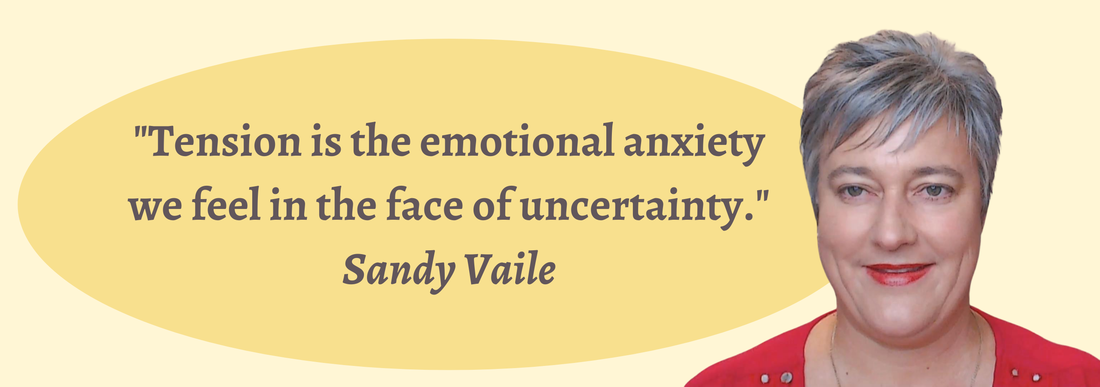|
Author: Sandy Vaile Originally published by Romance Writers of Australia in the Hearts Talk ezine, 2020. Republished by Romance Writers of Australia in the 30th Anniversary magazine 2021. How to use uncertainty to keep readers on the edge of their seats.We are all familiar with being so engrossed in a story that we can’t put it down: the “I’ll just read one more page before bed time” scenario. Tension is the critical element that keeps readers expectant regardless of the genre, place in the story, or whether a scene is action-packed or reflective. Read on to find out how to increase uncertainty and eek it out for as long as possible, to keep readers on the edge of their seats in your stories. What is tension?Sure, readers might anticipate good and bad events in a story, but it’s the emotional stress of waiting for a negative outcome that is the focus of story tension, because that is what makes hearts beat faster and stomachs somersault. Tension = Emotional investment + Stakes + Uncertainty How to create tensionIn order to create tension you need to:
Uncertainty is where the opportunity to really pump up the tension resides and there are a variety of techniques to enable it, like:
Readers love that anxious churning in the pit of their stomachs when they’re unsure how a situation is going to turn out, so it’s the author’s job to make them anticipate the worst and keep them desperate to know the outcome for as long as possible. Let’s explore some techniques you can use. CuriosityHumans are innately curious, so play on this by raising questions about characters or situations. Hint at a painful past experience or a secret they are desperate to keep hidden. (These hooks reel readers in and keep them wanting more.) Perfect characters are boring, so be clear about their flaws, e.g. a struggle with a moral decision, hiding information from loved ones or acting outside the law. When faced with unpleasant change, characters often react fiercely because they are desperate to avoid it, which is an excellent way to force them out of their comfort zone. Give them no option other than to face their worst fears, in order to lead them to personal growth. Instead of giving information away early on, gradually add it piece by piece, like a puzzle for the reader to solve. Another technique is to provide the reader with more information than the protagonist has. For example, the reader might learn about another character’s motives or secret when the protagonist hasn’t yet or they might know that a villain is waiting just around the corner. This leads them to dread a particular outcome that they believe they can see coming as the protagonist ploughs blindly forwards. Of course, just when all is about to be lost, is the perfect time for you to surprise them with a revelation. RevelationsUnexpected changes in the story help prolong tension. After leading the reader along a particular path of expectation, you might throw in a twist (surprise direction of the plot) or reveal startling information (a revelation) or even different take the reader in a suddenly new direction. Unexpected events unsettle readers and provide a peak of tension in the story. Readers wonder about the ramifications of these surprising events. Strengthen conflictConflict is at the core of a purposeful story with plenty of tension. You need to know what your characters desire and how far they will go to achieve it, then make sure you push them to their limits. Conflict leads to tension when there’s an emotional connection with the character. The audience needs to care about, or at least be interested in, what happens to them. Conflict can be internal, like a moral dilemma, or external, like a relationship breakdown. You can pit one character against another or a character against an idea/event/themself. Preferably characters will have both internal and external conflicts to deal with and the obstacles they face will continually increase in difficulty. It isn’t necessarily how big the conflict is that creates the tension, but how much the character wants it. Throw every obstacle and complication you can think of at them, so they have to prove how much they want that goal. And if their lives were difficult enough, why not add a sense of urgency? UrgencyUrgency can be created by a literal ticking clock, e.g. you have until noon to come up with the money, or a subtler deadline, e.g. if the love interest hasn’t made a move by the time the company sells, she’ll leave town. A finite amount of time puts characters under pressure to solve any problems that come their way or something terrible will happen. This goes hand-in-hand with making sure the stakes are high enough. If readers understand what a character has to lose, and it is dire (to the character at least), they will follow them through thick and thin. Stories that are layered with tension provide readers with the perfect arena to enjoy risk-taking and angst in a safe environment, as well as contentment when they finally reach the satisfying outcome. Keeping readers engaged doesn’t have to mean constant action or mortal danger, you just have to make them care about the characters, give them something to lose and then create uncertainty about the outcome and delay the resolution for the entire story. If you’d like to delve further into how to develop and sustain tension in your stories ...
join the discussions in Sandy's Facebook group. It'sa place where kindred spirits come to share industry and story craft information, and inspire one another to write quality novels.
7 Comments
6/7/2022 04:43:43 pm
So glad you found it helpful, Barbara. Thanks for taking the time to leave a comment.
Reply
Debbie Stein
10/8/2022 12:38:57 am
Good information
Reply
11/2/2024 07:19:14 am
That's awesome that you found the information helpful, Debbie.
Reply
10/8/2022 09:37:29 am
So glad you enjoyed this article, Barbara.
Reply
11/2/2024 07:20:05 am
I'm glad you found these tips helpful Eva.
Reply
Your comment will be posted after it is approved.
Leave a Reply. |
Fearless ProseEmpowering aspiring authors to confidently write novels they're proud to publish Categories
All
Archives
May 2024
|
© Sandy Vaile 2012-2024 |
Contact and Privacy Policy - About Sandy |




 RSS Feed
RSS Feed